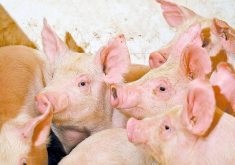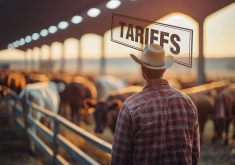TROUBLE SPOTS Chad VanderMeer says there are some bad apples when it comes to livestock dealers, and producers shouldn’t hesitate to complain if there’s a problem
Who you gonna call? When livestock goes missing or a dealer’s cheque doesn’t arrive, forget Ghostbusters — call Livestock Identification Services.
Plenty of people do call LIS if an animal wanders onto their property or disappears from their herd, says Chad VanderMeer, an inspector with the agency’s Education and Compliance Division and a cow-calf producer from Innisfail.
But it’s often a different story when it comes to business dealings, VanderMeer said at the recent UFA Cattle College in Mayerthorpe.
He reminded his audience that they have a role to play in enforcing regulations and standards.
Read Also

Horns aren’t unlocking anytime soon on livestock transport standards
Standards good enough meet the definition of “humane” animal transportation still vary widely between what what industry wants, what animal rights advocates want and, between the two, what federal regulators decide is good enough.
“That’s one thing I would like you to keep in mind — especially in purebred sales — there are habitually some very poor livestock dealers in that industry,” he said. “It’s tough for us at LIS to enforce the rules as it’s tough to get producers to actually complain.”
He highlighted a couple of areas. Regulations state that if more than one bidder shows up at a purebred sale, animals must be inspected.
“Purebred guys, if you only have your bulls or your females at a sale, an exemption can be obtained through LIS, but there can only be one contributor,” he said.
Producers who haven’t been paid should notify his agency, he added.
“It’s not always going to end up in the dealer losing his licence, but if we can put the pressure on them, it can make them follow the rules a little tighter,” he said.
The agency also pays the salaries of two RCMP livestock investigators — one in the south and one in the north — who conduct investigations into cattle theft or fraud.
“I know they’re working on a few cases right now,” VanderMeer said. “There’s one case that involves nine head, and another that involves over 7,000 head of livestock.”
Another LIS role is to license livestock dealers in the province. Without a licence, it’s illegal to resell an animal without 30 days of ownership. There are a number of steps a livestock dealer must take to obtain a licence, which allows them to market 12,000 head of cattle annually. To help producers in the case of non-payment, LIS administers an $8-million assurance fund.
“Every time you market your livestock through a licensed dealer in the province, you guys are paying five cents per head,” VanderMeer said. “That money is there in… case of a non-payment by a licensed livestock dealer.”
To receive payment, a producer must first make a claim against the livestock dealer’s security and then to the assurance fund, which covers up to 80 per cent of a loss.
Horses and cattle must also be inspected if the animals travel outside the province, even if it is for a show. Two different types of forms are used for transportation in the province — a livestock manifest and a livestock permit. The manifest is simply a list of livestock being moved from one location to the other. It needs to be used when cattle and sheep are transported within the province of Alberta. Horses only need to appear on a livestock manifest if they are transported for sale, slaughter or to an inspection site.
“The information on a manifest provides critical movement data related to a disease investigation,” said VanderMeer.
Manifests are not required if the person moving the livestock has already been issued a permit, or if an animal is being taken to the veterinarian.
LIS has developed an electronic version of the manifest, which is still in the testing phase. That version will be more convenient for high-volume feedlots.















